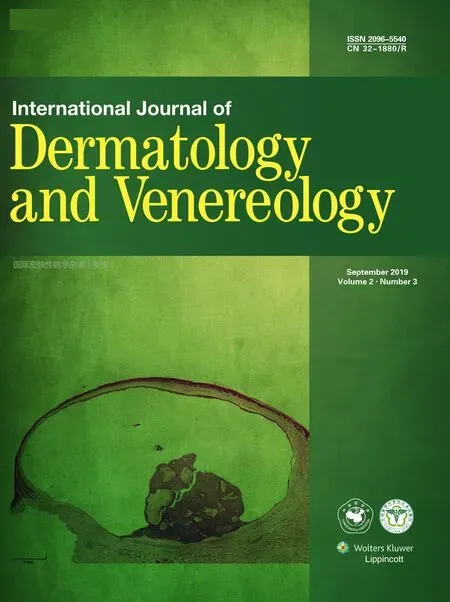Lentigines within Nevus Depigmentosus
Li-Wen Zhang, Wen-Ju Wang, Tao Chen∗, Li-Xin Fu, Lin Li
Department of Dermatovenereology, Chengdu Second People’s Hospital, Chengdu, Sichuan 610017, China.
Introduction
Nevus depigmentosus (ND) is classically defined as a congenital nonprogressive hypopigmented macule or patch and may result from functional abnormalities of melanocytes. Only a few cases of lentigines within ND have been reported to date,1-3and the relationship between lentigines and ND remains unknown.We herein describe a 20-year-old Chinese man with lentigines within ND. It is beneficial for enhancing our comprehension about disturbances of pigmentation so that we pay more attention to this interesting phenomenon.
Case report
A 20-year-old Chinese man presented to Chengdu Second People’s Hospital for a progressively enlarging hypopigmented patch and dark brown hyperpigmented macules on the right side of his neck and retroauricular areas that had developed after birth.The lesions were asymptomatic.No lesions were found on his eyes, mucous membranes,palms,or soles.The color of the brown macules exhibited no change after exposure to sunlight. No deficiencies were found in his intelligence, psychomotor abilities, or musculoskeletal system.The patient had no family history of similar cutaneous findings or tuberous sclerosis.
Physical examination revealed a hypopigmented patch on the right side of his neck and retroauricular areas.Within this region of leukoderma, multiple brown hyperpigmented macules with a diameter of 1-3mm were present(Fig.1A).There was no evidence of musculoskeletal abnormalities or stigmata. Wood lamp examination showed off-white accentuation without chalky-white fluorescence. Upon diascopy, no blending of the color of the lesion with its surrounding was observed.Dermoscopy showed multiple brown patches on a pale white background (Fig. 1B).
The patient was diagnosed with ND accompanied by lentigines. He refused further treatment and has been undergoing follow-up at the time of this writing.
Discussion
ND is classically defined as a congenital nonprogressive hypopigmented macule or patch. It may be localized,segmental, or systemic. The etiology of ND is unknown,but it is associated with a large reduction in melanosomes with variable melanocyte morphology;these melanosomes do not transfer efficiently into keratinocytes.4The few melanosomes that transfer into keratinocytes are immature and scattered in aggregates around the nucleus,whereas normal skin melanosomes are mainly supranuclear.4-5ND is a hypomelanotic disorder, not a hypomelanocytic disorder.It is characterized by a decrease in the melanin content of the epidermis as shown by staining with hematoxylin and eosin.4-5Tyrosinase activity in epidermal melanocytes is decreased in ND,further indicating decreased melanosome function.5ND should be differentiated from nevus anemicus, hypomelanosis of Ito, vitiligo, and albinism. ND is rarely accompanied by other abnormalities, but there have been reports of associated seizures, intellectual disability,unilateral limb hypertrophy, atopic dermatitis, and abnormal systemic features.6Furthermore, a few cases of lentigines within ND have been reported.1-3

Lentigines are hyperpigmented macules that do not fade away in the absence of ultraviolet exposure. Histopathological examination shows increased melanin in the basal cell layer and increased numbers of singly arranged melanocytes. Agminated or segmental lentiginosis manifests as a circumscribed group of lentigines that are arranged in a segmental pattern and develop during childhood. They are presumed to represent mosaicism of an unidentified gene.7However, the pathogenetic mechanisms underlying how lentigines develop within ND remain unknown.A possible explanation is that a reverse mutation in one of the genes involved in pigmentation occurs,restoring pigmentary function.2Another plausible Figure 1. Clinical and dermoscopic features of the lesions.(A)A hypopigmented patch was observed on the right side of the patient’s neck and retroauricular areas. Within this area of leukoderma, multiple hyperpigmented brown macules were present. (B) Dermoscopic features of the lesions (original magnification, ×50).explanation for this paired skin disorder is the conception of “twin spots” in which both lesions have different recessive mutations occurring on the same chromosome and manifest visibly only in the rare event of somatic recombination occurring at an early developmental stage.1Zhanget al.3reported a case of lentigines within ND and considered a possible explanation to be mosaicism.Somatic revertant mosaicism is the coexistence of cells carrying inherited genetic mutations with cells that have undergone spontaneous changes that correct the mutant phenotype.8However, identification of the factors that determine this rare phenomenon requires further genetics studies involving more patients.
Acknowledgement
The work was supported by Sichuan Province Medical Innovation Project for Youths (No. Q15003) and Chengdu Technological-Benevolent Project (No. 2015-HM01-00095-SF).
- 国际皮肤性病学杂志的其它文章
- Solid-Cystic Hidradenoma
- Arteriosclerosis Obliterans Presenting as Multiple Leg Ulcers: A Case Report
- Interstitial Mycosis Fungoides with Systemic Sclerosis-Like Features: A Case Report
- Nasal Type Extranodal NK/T-Cell Lymphoma Presenting with Unilateral Facial Erythemas,Nodules, and Necrosis
- Subungual Exostosis Misdiagnosed as Subungual Wart
- Severe Port Wine Stain with Significant Nodules and Alveolar Bone Invasion Leading to Restricted Mouth Opening

